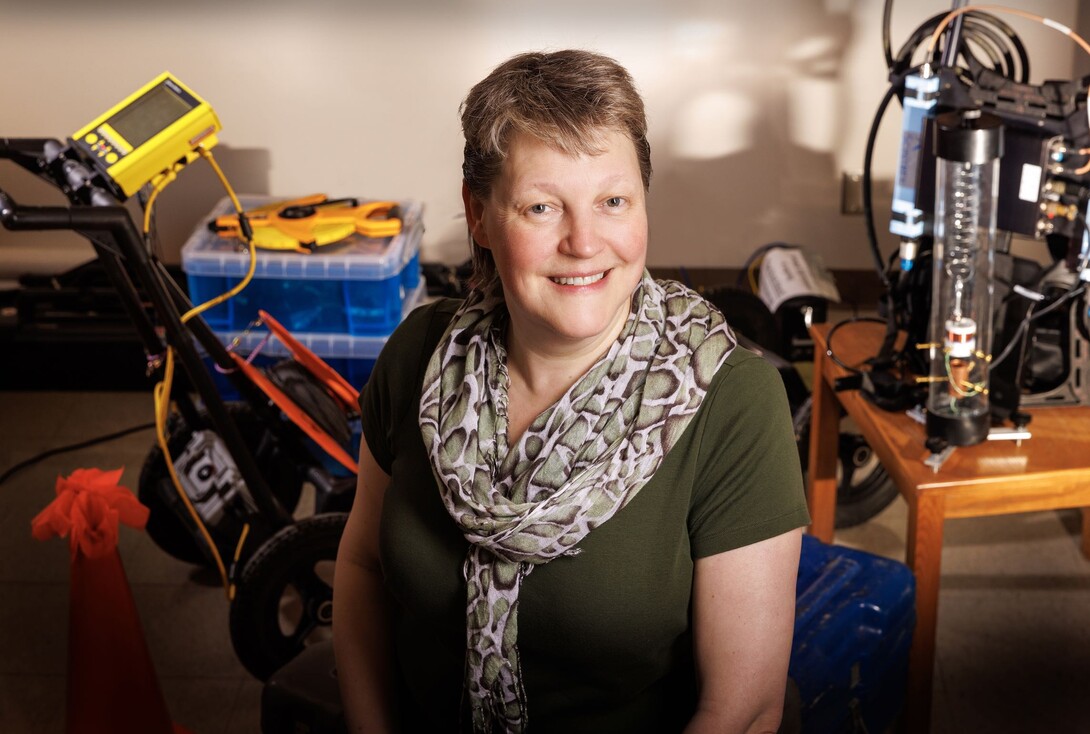
In the last few years, an unexpected development has rocked the geoscience world — the discovery of continental material in Iceland that led to a hypothesis about a previously unknown submerged continent in the Northern Atlantic. A University of Nebraska-Lincoln geophysicist is taking a fresh look at data to find answers about this tectonic wonder and, along the way, plans to build a robust geophysics program that could position the university as a leader in educating students in the field.
Irina Filina, assistant professor of Earth and atmospheric sciences, has received a $746,284 five-year grant from the National Science Foundation’s (NSF) Early Career Development Program to conduct this research.
Geologists dubbed the possible continent “Icelandia” and now are considering a theory that, along with challenging long-held ideas about the makeup of the crust underlying the North Atlantic, also could force reconsideration of how continents break apart, how new oceans open and how volcanic islands such as Iceland form.
Filina said at this early stage, she’s somewhat agnostic about the existence of Icelandia.
“This is intriguing everyone, but it’s a new concept. I cannot say that it’s well-accepted yet. … I don’t know if I believe it, but it’s a new hypothesis that would be cool to test.”
That’s what Filina proposes to do.
Filina said she won’t be gathering new data but rather taking existing geophysical data and finding new ways to integrate it to provide answers about the nature of the crust underlying the Northern Atlantic, contributing to broader scientific understanding. That data will include seismic, gravity and magnetic anomalies in the region, as well as findings from several decades of scientific drilling.
“The power is in the integration of various datasets,” she said. “When you combine different types of data, your range of possible solutions decreases dramatically.
“This analysis will transform our understanding of the Northern Atlantic and will elucidate the tectonic processes responsible for breaking continents and opening new oceans,” she said.
NSF funding will enable Filina to build a new comprehensive tectonic model of the Northern Atlantic that will fit various tectonic pieces into the “puzzle” of the pre-break-up tectonic reconstruction and develop a coherent geological story that explains all datasets and observations. It’s an approach she previously applied to the Gulf of Mexico, another complex tectonic region.
The Northern Atlantic long has been an ideal place to study the planet’s tectonic history, and this enticing new theory is challenging decades of theories about how supercontinents break apart, such as the supercontinent Pangea that existed during the late Paleozoic and early Mesozoic eras. Scientists have long believed that Pangea gradually broke up from 250 million years ago leading to the continental distribution we see today. The northern Atlantic opened the last, about 56 million years ago, and was thought to be primarily hosted by oceanic crust. The discovery of continental material in Iceland led to the new tectonic hypothesis, suggesting that Pangaea did not fully break up along the mid-Atlantic, but instead, part of it stretched out, leaving Icelandia’s continental crust crossing the divide. If that theory holds true, this hidden continent of Icelandia could cover up to 386,000 square miles from Greenland all the way to Europe – an area roughly five times larger than the state of Nebraska.
Filina participated in the International Ocean Discovery Program to the Norwegian margin a couple of years ago that whetted her interest in the tectonics of this region. The expedition recovered a multitude of igneous and sedimentary rocks from 10 sites.
“These rocks provided us with a lot of valuable information about the tectonic history of the region,” she said.
She will use the measured physical properties (densities and magnetic susceptibilities) of the recovered rock samples to constrain integrated geophysical modeling of the Northern Atlantic.
Like all CAREER grants, Filina’s pairs an education component with its research goals. Filina, currently the only geophysicist in her department, wants to further the geophysics program at Nebraska and promote geophysics as a career of choice. To engage students in interactive learning experiences centered around an integrated approach, she plans to incorporate mini-research projects into existing geophysics courses and organize a professional speaker series. She will also teach a weeklong summer course, Physics of Earth, to high school students to spark interest in geophysics among diverse students, including Girls Inc. of Lincoln. In addition, she will develop and disseminate education activities and modules to be used in introductory geoscience courses, which can be adapted for both college and high school levels and are focused on an integrative approach in geosciences.
The National Science Foundation’s CAREER award supports pre-tenure faculty who exemplify the role of teacher-scholars through outstanding research, excellent education and the integration of education and research.







